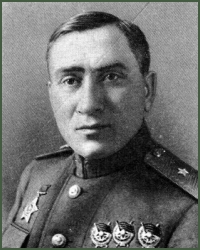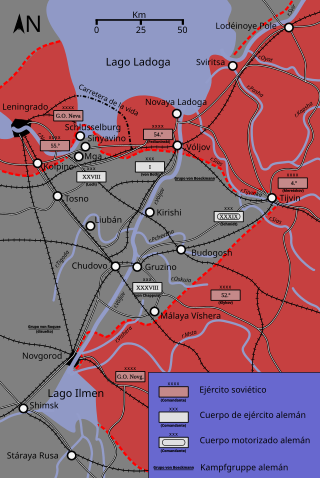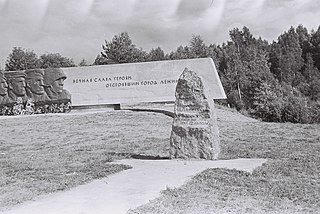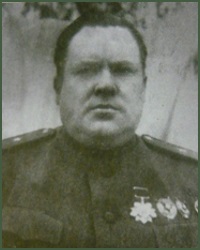
The 305th Rifle Division was formed for the first time as a standard Red Army rifle division shortly after the German invasion. It was soon sent north to the Volkhov Front near Novgorod. In the winter of 1942 it participated in an offensive to try to break the siege of Leningrad which ended with it and most of the rest of the attacking force being cut off and gradually annihilated during the spring. A second 305th was raised a few months later in the southern part of the front, where it distinguished itself in the final liberation of Belgorod. It continued in combat through Ukraine and Poland before ending the war near Prague.
The Red Army's 54th Army was a Soviet field army during the Second World War. It was first formed in the Leningrad Military District in August, 1941, and continued in service in the northern sector of the Soviet-German front until the end of 1944. It spent much of the war attempting to break the German siege of Leningrad, in which it helped to achieve partial success in January, 1943, and complete success one year later. During these operations the soldiers of the 54th served under five different commanders, most notably Col. Gen. Ivan Fedyuninsky in the winter of 1941–42. After helping to drive Army Group North away from Leningrad and into the Baltic states in the first nine months of 1944, the army was deemed surplus to requirements on the narrowing front, and was officially disbanded on the last day of the year.
The 321st Rifle Division was formed in September 1941, as a standard Red Army rifle division, based on an existing division of militia. This formation had an extremely short career, coming under devastating attack in the north of the Crimea on the day of its redesignation and being officially disbanded just over a month later. A second division began forming in the Transbaikal in February 1942, and served in the defensive and offensive fighting around Stalingrad, eventually distinguishing itself sufficiently to be redesignated as the 82nd Guards Rifle Division. The world had not seen the last of the 321st, however, as a new division was formed from two existing rifle brigades in the spring of 1944, which gave very creditable service for the duration, completing its combat path in northeastern Germany, and serving into the postwar period.
The 325th Rifle Division was formed in September 1941, as a standard Red Army rifle division, made up of older reservists and young men with no prewar training. As with many other divisions in the 320–330 series it was flung into the fighting west of Moscow in the 10th Army to defend the capital and then to take part in the winter counteroffensive. After a year on a quiet sector the division rejoined the fighting in the late winter of 1943, eventually distinguishing itself sufficiently to be redesignated as the 90th Guards Rifle Division. After disappearing from the Soviet order of battle for more than a year a new division was formed in the spring of 1944, based on a cadre of two distinguished rifle brigades, and gave very creditable service for the duration, completing its combat path in East Prussia.
The 378th Rifle Division was an infantry division of the Red Army that began forming in August 1941 in the Siberian Military District, before being sent to the vicinity of Leningrad, where it spent most of the war. The soldiers of this division fought until early 1944 to break the siege and drive off the besieging German forces, distinguishing themselves in the liberation of Novgorod. Finally, the division was redeployed to advance into the Baltic states in 1944 and into East Prussia in the winter of 1945. As the war was ending the 378th was disbanded to provide replacements for other divisions. Nevertheless, it had compiled a very creditable combat record for any rifle division.

The 311th Rifle Division was a standard Red Army rifle division formed on July 14, 1941 at Kirov before being sent to the vicinity of Leningrad, where it spent most of the war, sharing a similar combat path with its "sister", the 310th Rifle Division. The men and women of the division were fully engaged in the struggle for Leningrad until early 1944, fighting in several offensives to drive a lifeline through the German positions to the besieged city, and then to finally drive the besiegers away. When this was accomplished, the division was redeployed to take the fight into the Baltic States in 1944, then into the German heartland in the winter and spring of 1945. It ended the war north of Berlin after compiling a very distinguished record of service.

The 314th Rifle Division was a standard Red Army rifle division formed on July 15, 1941 at Petropavlovsk in northern Kazakhstan, before being sent to the vicinity of Leningrad, in the 7th Separate Army east of Lake Ladoga, facing the Finnish Army in East Karelia for more than a year. In consequence the division saw relatively uneventful service on this mostly quiet front until the autumn of 1942, when it was moved south to face German Army Group North, and took a leading role in Operation Iskra, which finally drove a land corridor through to besieged Leningrad in January 1943; a year later it also served prominently in the offensive that broke the enemy siege for good. During the summer the division played a role in the offensive that drove Finland out of the war. Following this, the 314th spent a few months fighting in the Baltic States, before being reassigned southwards to 1st Ukrainian Front to take the fight into Poland and then into the German heartland in the winter and spring of 1945. It ended the war in Czechoslovakia with a distinguished record of service.
The 285th Rifle Division was an infantry division of the Soviet Union's Red Army during World War II. Formed in the summer of 1941, the division entered combat during the fall of that year, fighting in operations attempting to break the siege of Leningrad. The division fought in the same area until the relief of Leningrad in February 1944, when it began advancing into the Baltic states. The division served in the Baltic states until October, when it transferred south to Poland, where it fought in the Vistula–Oder Offensive and Silesian Offensives in early 1945. The division was disbanded soon after the end of the war in the summer of 1945.
The 364th Rifle Division was an infantry division of the Red Army during World War II.
The 374th Rifle Division was raised in 1941 as an infantry division of the Red Army, and served for the duration of the Great Patriotic War in that role. It began forming in August 1941 in the Siberian Military District. It joined the fighting front in December with the new 59th Army along the Volkhov River and it continued to serve in the fighting near Leningrad until early 1944. The dismal fighting on this front gave little opportunity for a unit to distinguish itself, and the division did not finally earn a battle honor until late January 1944, during the Leningrad–Novgorod Offensive. It continued to serve in the summer and autumn offensive through the Baltic States, becoming so reduced in strength that its remaining infantry was consolidated into a single understrength regiment which nevertheless won a battle honor in the liberation of Riga. The 374th ended the war in Latvia, helping to contain and reduce the German forces trapped in the Courland Pocket, and was disbanded shortly thereafter.
The 376th Rifle Division was raised in 1941 as an infantry division of the Red Army, and served for the duration of the Great Patriotic War in that role. It began forming in August 1941 in the Siberian Military District. It followed a very similar combat path to that of the 374th Rifle Division. It joined the fighting front in December with the new 59th Army along the Volkhov River and it continued to serve in the battles near Leningrad until early 1944. The division took horrendous casualties in the combat to create and hold open a passage to the 2nd Shock Army during the Lyuban Offensive and was itself partly or fully encircled at several times during this dismal fighting. The division finally left this region as it advanced during the Leningrad–Novgorod Offensive in January 1944 and in July won a battle honor in the liberation of Pskov, while its 1250th Rifle Regiment was awarded the Order of the Red Banner. In October the 376th as a whole would also receive the Red Banner for its part in the liberation of Riga. The division ended the war in Latvia, helping to contain and reduce the German forces trapped in the Courland Pocket, and was reorganized as a rifle brigade shortly thereafter.

The 377th Rifle Division was raised in 1941 as an infantry division of the Red Army, and served for the duration of the Great Patriotic War in that role. It began forming in August 1941 in the Urals Military District. It followed a very similar combat path to that of the 374th and 376th Rifle Divisions. It joined the fighting front in December with the 4th Army, and then briefly came under command of 2nd Shock Army, but soon moved to the 59th Army along the Volkhov River, and continued to serve in this Army's battles near Leningrad until early 1944. The division took very heavy casualties during the Lyuban Offensive in several attempts to relieve the beleaguered 2nd Shock Army. After rebuilding the division held the Army's bridgehead over the Volkhov during 1943, and finally advanced during the Leningrad–Novgorod Offensive in January 1944, taking part in the assault that liberated Novgorod. During the spring the division saw heavy fighting in the battles for Narva before moving south for the summer offensive into the Baltic states. In September it won a battle honor in the liberation of Valga, and in October also received the Order of the Red Banner for its part in the liberation of Riga. The division ended the war in Latvia, helping to contain and reduce the German forces trapped in the Courland Pocket, and was disbanded later in 1945.
The 382nd Rifle Division was raised in 1941 as an infantry division of the Red Army, and served for the duration of the Great Patriotic War in that role. It began forming on August 10 in the Siberian Military District. It joined the fighting front in December with the new 59th Army along the Volkhov River. Apart from a few weeks in 1944 the division served in either the Volkhov Front or the Leningrad Front for the entire war. It suffered horrendous casualties after being encircled in the swamps and forests near Lyuban and was severely understrength for many months afterwards while serving on a relatively quiet front. It remained in the line in the dismal fighting near Leningrad until early 1944 with little opportunity to distinguish itself, and the division did not finally earn a battle honor until late January, 1944, during the Leningrad–Novgorod Offensive. Following this the division was moved to the Karelian Isthmus and entered the summer offensive against Finland in the reserves of Leningrad Front before being assigned to the 23rd Army. Following the Finnish surrender it was redeployed westward, helping to mop up pockets of enemy forces in the Baltic states in early 1945. The 382nd ended the war in Latvia, helping to contain and reduce the German forces trapped in the Courland Pocket, and was officially disbanded in February, 1946.
The 225th Rifle Division was an infantry division of the Red Army, formed in December 1941 from the remnants of the pre-war 3rd Tank Division and based on the shtat of July 29, 1941. The 3rd Tank's single rifle regiment was joined by two reserve rifle regiments, and its howitzer regiment was converted to a standard artillery regiment. As part of 52nd Army in Volkhov Front it took part in largely local fighting in the Novgorod area, seeing combat in several abortive attempts to retake the city until it finally played a main role in its liberation in January 1944 and received its name as a battle honor.
The 239th Rifle Division was formed as an infantry division of the Red Army after a motorized division of that same number was reorganized in the first weeks of the German invasion of the Soviet Union. It was based on the shtat of July 29, 1941, and remained forming up and training in Far Eastern Front until early November when the strategic situation west of Moscow required it to be moved by rail to Tula Oblast where it became encircled in the last throes of the German offensive and suffered losses in the following breakout. When Western Front went over to the counteroffensive in the first days of December the division was in the second echelon of 10th Army and took part in the drive to the west against the weakened 2nd Panzer Army. As the offensive continued it took part in the fighting for Belyov and Sukhinichi before being subordinated to the 1st Guards Cavalry Corps in January 1942 to provide infantry support. It then became involved in the complicated and costly battles around the Rzhev salient as part of 50th, 10th and 31st Armies until December. It was then moved north to Volkhov Front, and took part in several operations to break the siege of Leningrad, mostly as part of 2nd Shock and 8th Armies. As part of 59th Army it helped to drive Army Group North away from the city and was rewarded with the Order of the Red Banner in January 1944. During the following months it continued to advance through northwestern Russia but was halted by the defenses of the Panther Line in April. The division took part in the advance through the Baltic states in the summer of 1944 but in February 1945 it was transferred to 1st Ukrainian Front, rejoining 59th Army as part of 93rd Rifle Corps and fought in upper Silesia. In the last weeks of the war the 239th was advancing on Prague, but despite its distinguished record it was selected as one of the many divisions to be disbanded during the summer of 1945.

The Tikhvin Offensive was a military operation undertaken by the German army in October 1941 during World War II in the course of Operation Barbarossa. The offensive, conducted entirely around the Volkhov River, was launched by Adolf Hitler with the primary objective of cutting off the supply routes supplying Leningrad. In addition, the German high command intended the deployment of troops in the region to cover the northern flank of the parallel offensive that the Third Reich was launching towards Moscow at that time and also to link up with the allied forces in Finland. The powerful Soviet counteroffensives, added to the accumulated attrition of the German army and the overextension of its logistic network, led to the collapse of the Army Group Norths and the German withdrawal from the occupied ground in the succession of combats.
The 259th Rifle Division was formed from reservists as a standard Red Army rifle division, very shortly after the German invasion, in the Moscow Military District. It was largely based on what would become the shtat of July 29, 1941. It was assigned to the 34th Army of Reserve Front before the end of July, but this Army was soon reassigned to Northwestern Front. Under these commands it took part in the Staraya Russa offensive operation in August. It suffered significant casualties in its first operation but after falling back toward Leningrad it took part, as part of 52nd Army, in both the defense of Tikhvin and the following counteroffensive that retook the city in one of the first major German reverses. In the new year the 259th was involved in the Lyuban offensive, mostly under command of the ill-fated 2nd Shock Army, and this struggle continued into June. Enough of the division escaped encirclement that it avoided disbandment, and it was sufficiently restored by late August that it was committed to the second Sinyavino offensive, eventually becoming encircled again and forced to break out, at considerable cost. In early October it was withdrawn to the Reserve of the Supreme High Command for a lengthy period of restoration, well into 1943, in 2nd Reserve Army, as it moved well to the south.
The 198th Rifle Division was formed as an infantry division of the Red Army after a motorized division of that same number was reorganized in the first months of the German invasion of the Soviet Union. It was based on the shtat of July 29, 1941, with several modifications. It entered combat as a rifle division during the Tikhvin Offensive in December 1941 as a reinforcement for 54th Army, helping to drive elements of Army Group North back to the Volkhov River from their earlier gains. It would remain near that river line into early 1944. During 1942 it took part in several abortive offensives in an effort to relieve the siege of Leningrad, suffering heavy losses in one of them. In 1943 it was mainly used for line-holding duties at a reduced establishment, in an area where German forces were strictly on the defensive. The 198th was brought back up to something approaching the current establishment by the start of 1944 and, during the offensive that finally drove Army Group North away from Leningrad, it helped to maintain the offensive's momentum following the initial breakthrough as part of 119th Rifle Corps. It was finally reassigned to 3rd Baltic Front's 67th Army in April after it was halted at the Panther Line near Pskov. In August it briefly returned to 54th Army during the advance through the Baltic States, and after the capture of Riga it remained in western Latvia for the duration of the war, serving under several commands, mostly the 42nd and 10th Guards Armies. It was one of the very few divisions that served throughout the war without receiving any battle honors or decorations. Despite this, the 198th continued its service, now in western Siberia, for another 10 years, before being redesignated as the 23rd Rifle Division.

The 191st Rifle Division was an infantry division of the Red Army, originally formed as part of the prewar buildup of forces, based on the shtat of September 13, 1939. It began forming just months before the German invasion at Leningrad. At the outbreak of the war it was still not complete and was briefly held in reserve before being sent south to take up positions as part of the Luga Operational Group. After defending along the Kingisepp axis it was forced to withdraw in late August as part of 8th Army, and helped to establish the Oranienbaum Bridgehead. In October it was ferried into Leningrad itself, but was soon airlifted to 4th Army, which was defending against a German drive on Tikhvin. Although the town fell in November, within a week a counterstroke was begun against the vastly overextended German force, which was forced to evacuate on December 8. As it pursued to the Volkhov River the 191st was awarded the Order of the Red Banner, one of the first divisions so honored during the war. During the Lyuban Offensive it penetrated deep into the German lines as part of 2nd Shock Army, but was cut off, and only fragments of the division emerged from the encirclement in early June, 1942. In September it was committed from reserve in an effort to sustain the Second Sinyavino Offensive, but this failed and the division was again encircled and forced to break out at considerable cost. During Operation Iskra in January, 1943 the 191st played a secondary role in reestablishing land communications with Leningrad, partially raising the siege. The division was relatively inactive as part of 59th Army along the Volkhov during the remainder of the year, but in January, 1944 it took part in the offensive that finally drove Army Group North away from Leningrad and received a battle honor for its role in the liberation of Novgorod. As the offensive continued the division advanced as far as Narva, where it was held up for several months. In late July, it staged an assault crossing of the river and helped take the city, for which one of its regiments also gained a battle honor. Following this victory the 191st advanced into Estonia, gradually moving toward the Latvian capital of Riga. Once this city was taken the division was moved south, and by the start of the Vistula–Oder offensive in January, 1945 it was part of 50th Army in 2nd Belorussian Front, but it was soon reassigned to 49th Army, where it remained for the duration. During the East Pomeranian operation it advanced on Gdańsk, and two of its regiments would later receive decorations for their roles in the campaign. During the final campaign into central Germany the 191st crossed the Oder River before pushing northwest into Mecklenburg-Vorpommern; several of its subunits would receive decorations as a result of this fighting in the final days. The division had a fine record of service that encompassed most of the struggle for Leningrad, but it would be disbanded in July.
The 177th Rifle Division was formed as an infantry division of the Red Army south of Leningrad in March 1941, based on the shtat of September 13, 1939. As Army Group North advanced on Leningrad the division, still incomplete, was rushed south to the Luga area. In mid-July it helped provide the initial resistance to the LVI Motorized Corps which set up the counterstroke at Soltsy, the first significant check of the German drive on Leningrad. In August the German offensive was intensified and the defenders of Luga were encircled and forced to escape northward, losing heavily in the process. A remnant of the 177th reached Leningrad, where it received enough replacements to again be marginally combat-effective. In October to was moved to the Neva River line as part of the Eastern Sector Operational Group. After briefly coming under command of 55th Army it was moved across Lake Ladoga to join 54th Army. It remained in this Army, as part of Volkhov Front, almost continuously until early 1944, serving west of the Volkhov River. It took part in the winter offensive that finally drove Army Group North away from Leningrad and earned a battle honor for the liberation of Lyuban, where part of it had been raised in 1941. Following this victory it was reassigned to 2nd Shock Army in Leningrad Front, and took part in the unsuccessful efforts to retake the city of Narva, before being removed to the Reserve of the Supreme High Command in April for further rebuilding and replenishment. It returned to the fighting front at the beginning of May in 21st Army facing Finland. At the outset of the final offensive against Finland it was in 23rd Army in the Karelian Isthmus. During this operation it advanced through the central part of the isthmus against determined Finnish resistance. The division remained facing Finland until early 1945, when it was moved to Latvia and spent the remainder of the war containing the German forces trapped in Courland, eventually assisting in clearing the region after the German surrender in May. It was moved to the Gorkii Military District in August, and was disbanded there in April 1946.







